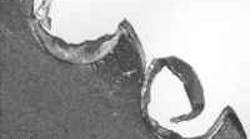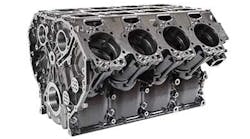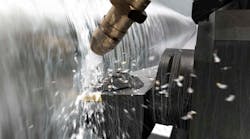The sights and sounds of failure
Blade gullets loaded with chips indicate excessive feedrates, too fine a tooth pitch, or incorrect coolant mix, volume, or flow.
Blade-body gullet cracks are precursors to fatigue failure. Shops should replace the blade and adjust tension and feed settings.
Making bandsawing jobs more productive and efficient is as easy as getting to know how the cutoff operation should look and sound. Tell-tale signs such as tooth damage, crooked cuts, or unusual noises can indicate impending problems, thus giving shops the opportunity to correct them before sawing production comes to a complete standstill.
For starters, shops should visually check bandsaw-blade teeth for heavy wear or chips welded to the tips. Stripped, chipped, or damaged teeth after a cut often indicate improper feed and speed settings or inadequate coolant. A low, insufficient feedrate causes premature dulling and vibration which further damage cutting edges.
Excessive speeds generate intense heat, which welds gummy chips to sawblades. This increases stress on teeth and smears workpieces. To prevent this from happening, shops should use cutting fluids that contain lubricants, anti-weld additives, and wetting agents. Coolant dissipates heat, extends blade life, and prevents thermal distortion. However, the chlorine, sulfur, and other extreme-pressure additives in straight cutting fluids may adversely affect workpieces as residual fluid gets hot.
Shops should also be concerned with coolant flow and direction. Properly aimed nozzles maximize lubrication and flush away chips. Splashing oil all over the saw does little to lubricate the workpiece. Likewise, mist-cooling systems that fog small quantities of fluid on blades may provide a cleaner workplace but do not remove chips.
Excessive wear on the sides of blade teeth indicates they are rubbing in the kerf or against the saw's side guides. If this happens, shops should re-adjust overall machine settings, including the blade guides. They should also double-check tooth pitch to make sure it is not too fine for the material being cut. Keeping chip brushes working properly is also important. If bandsaw-blade teeth gullets are full of chips, shops may want to select a different tooth pitch. What shops want to see are chips curled and shaped like sixes and nines. These are evidence of a properly chosen blade that is cutting productively.
In addition to its teeth, a bandsaw blade's body also provides a wealth of information. For instance, scratches or scoring on the blade backing warn of impending fatigue failure. Shops should replace blades and/or perform other necessary machine maintenance.
Excessive wear on a blade's back edge indicates a possible guide-setting problem. For proper alignment, shops shouldn't set guides too far apart or too tight. Also, chip buildup in the guides scores the top of the blade.
When there are cracks in a blade's gullets, tension and feed pressure need adjustment. Blade specialists typically specify a 30,000-psi tension on machines running bimetal blades 1-in. wide and above—manufacturers usually specify the right tension for narrower blades.
Other visual clues shops should look for are chips or cut pieces blue with heat discoloration or smoke rising from the workpiece. Both of these should warn operators to slow sawing speeds. A crooked cut indicates a need for blade replacement or that guides are too far apart, worn, or loose.
Shops should always check their sawing machine's overall settings, and slow the feedrate if necessary. Bandsaw-blade teeth easily penetrate soft alloys like aluminum, so it is not uncommon for shops to over-feed and overload blades.
Increasing blade speed decreases chip load per tooth and helps evacuate chips to prevent crooked cuts and broken teeth. Damaged, stripped, or worn teeth cause blade deflection and a ruined cut.
Besides visual inspections, shops should listen for vibration and unusual noises coming from a sawing operation. A correctly tensioned blade along with properly set feeds and speeds make for vibrationfree sawing. However, harmonic sounds, similar to guitar strumming, signal trouble. They warn that either the blade tension is too low; the distance between guides is too wide; blade pitch or cutting data is incorrect; or the coolant mixture is too lean for that particular job.
High-pitched squealing indicates chip-formation problems and microvibration caused by incorrect cutting data or coolant mixture. For some materials this sound is normal, but for others, it is a cue to adjust machine settings. If a moving blade emits a clicking sound, it means there is a crack or some other irregularity in the blade.
Start with the right blade
The right blade minimizes overall sawing costs and maximizes productivity. The wrong blade erodes throughput, takes a toll on sawing machines, and puts expensive workpieces at risk.
Choosing the best bandsaw blade for a particular job depends on material machinability and surface condition and workpiece geometry. Aluminum and other soft metals, for instance, produce low cutting forces and large chips and are best cut with bimetal blades. Bimetal blades have deep tooth gullets that prevent clogging. Carbide-tipped blades, on the other hand, resist abrasion for highspeed cutting. However, they don't work effectively or economically for all bandsawing operations.
To reap the benefits of carbide blades, operators need to adjust speeds, feeds, and tension so that a blade's backing and teeth wear evenly. By comparison, using blades with harder teeth, tighter pitches, and smaller gullets lets operators cut harder ferrous metals that require high cutting forces and make finer chips.
Uniform, fine-pitch blades resist tooth breakage and wear to make easy work of thin sheet, tube, or pipe. Variable-pitch blades nullify vibration and are a good choice for smoothly cutting bundled shapes and profiles.
Blades with precision-ground teeth provide a uniform, precision edge that increases blade life 60% to 70% as compared to milled-tooth blades. Grinding eliminates variation in tooth height, so all the teeth encounter the same cutting forces and contribute to cutting action.
The result is fewer blade changes, which reduces blade-replacement costs and unproductive machine downtime. Lower cutting forces also reduce machine wear and tear.
| Beyond sight and sound |








